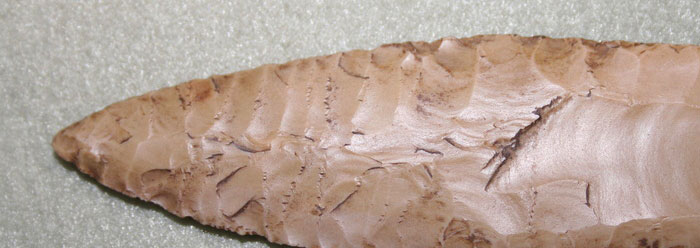Evolutionary anthropologists once thought that stone knives were developed in the late Stone Age, around 40,000 years ago. That figure was later revised to 200,000, around the Middle Stone Age, when stone blades were discovered in lower strata.
Now stone blades have been found in Kenyan rock layers dated at about 500,000 years old according to evolutionary estimates.1 Thus, the original claim that “40,000 years ago, man made his first stone implements” was off by over 92 percent, suggesting that evolutionary depictions of human history are unreliable.
The news of 500,000-year-old knives may be frustrating to evolutionary anthropologists, who had already faced difficulty adjusting history to accommodate the supposedly 200,000 and 300,000-year-old stone knives found in recent decades.2 An attempt was made to reconcile those data to the old historical framework by reasoning that since modern man only emerged from an ape-like ancestor some 200,000 years ago, pre-modern (almost-man) creatures who lived over 380,000 years ago must have been able to make knives, even though they were quite ape-like in other respects.
But these newly-discovered knives predate even “pre-modern” man’s imagined ability to make such tools. A difference of about 160,000 years is significant enough that it cannot easily be ignored. Another major alteration is needed to accommodate the new data.
Although puzzling to evolutionary scientists, evidence such as these stone knives fits perfectly with the biblical record, which teaches that mankind was created fully human from the beginning, without any “ape-man” ancestors. In fact, ape-kind and mankind are described as being created as distinct kinds (Genesis 1:25), thus ruling out that “kind” of evolution.
Removing the restriction of long-age assumptions, the stone knives were most likely made somewhere on the order of several thousand years ago, at least since the time of the Tower of Babel, circa 2200 B.C. The forced dispersion of peoples from the Middle East outward across the rest of the world, as described in Genesis 11, caused migrating families to start from scratch, eking out an existence with stone knives and cave dwellings for a time. The volcanic deposits that sandwiched the newly-discovered African blades could well be remnants of post-Flood volcanic activity, marks of a time when earth’s crust was less stable, still settling down from the great, year-long upheaval of Noah’s Flood. This historical picture, unlike the standard evolutionary one, is based on eyewitness accounts, not on unfounded and ever-changing presuppositions.
In describing the “human ancestors” who made the Kenyan blades, the journal Science stated that “these toolmakers were capable of more sophisticated behavior than previously thought.”1 Of course they were. They were fully-created human beings!
References
- Gibbons, A. Oldest Stone Blades Uncovered. ScienceNOW Daily News. Posted on sciencenow.sciencemag.org April 2, 2009, accessed April 6, 2009.
- Balter, M. The Long Road to Modernity. ScienceNOW Daily News. Posted on sciencenow.sciencemag.org December 1, 2008, accessed April 6, 2009. This article reported on the research published in Morgan, L. E. and P. R. Renne. 2008. Diachronous dawn of Africa's Middle Stone Age: New 40Ar/39Ar ages from the Ethiopian Rift. Geology. 36 (12): 967-970.
* Mr. Thomas is Science Writer at the Institute for Creation Research.
Article posted on April 10, 2009.














